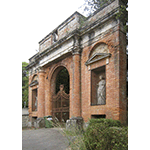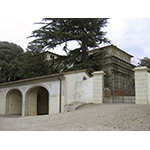Medici Villa "La Màgia"
The oldest nucleus of the villa, formed by a castrum or fortalice, probably dates to the first half of the 14th century. In 1584, Grand Duke Francesco I de’ Medici purchased La Màgia and the adjoining property which also included two mills and two kilns, one of which produced mortar, the other tiles. La Màgia was the Medici’s first rural investment on the eastern slopes of Montalbano, and was the place from which they administered and controlled their possessions. Between 1584 and 1587, the grand duke commissioned Bernardo Buontalenti to reconstruct the old fortalice and transform it into a country residence. Buontalenti was also responsible for fixing up the artificial lake (which dried in the 18th century), destined to fishing, and connected to the villa by a tree-lined lane.
In 1645, Ferdinando II de’ Medici sold La Màgia to Pandolfo Attavanti. Between the late 17th and early 18th centuries, the new owners conducted works that modified the villa’s internal layout, but left it practically unaltered externally. Between 1715 and 1716, a lemon-house with a fountain in the middle called the "basin of the new garden" was built on the western side of the garden.
In 1766, the villa was purchased by Giulio Giuseppe Amati who built the lemon-house on the eastern side of the garden, opposite the earlier one. This period also marked the garden’s final arrangement which included channelling water to irrigate the plants. Around the mid 18th century, citron trees were planted to form two woods, in addition to flowers of various types (jasmines, carnations, lilies, etc.), planted in geometric flower-beds, while olive trees, grapevines and mulberries were planted on the surrounding land. On the eastern side of the villa, Amati also created a romantic garden that is entered through a monumental neoclassical wrought-iron gate. The garden is characterised by footpaths that wind through woods of cypress, holm-oak and laurel trees, and lead to a small manmade lake. The villa has been property of the city since late 1999.
****************************
Texts by Graziano Magrini
English translation by Victor Beard
Last update 12/feb/2008





